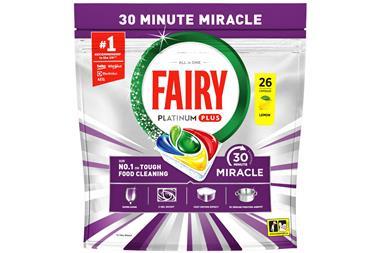THINKING BIG
United Norwest's larger stores are in good hands as the man in charge of running them has two decades of experience at Asda under his belt.
General manager of the large stores group Austin Waterworth says they are a great asset to the co-operative's core of convenience stores and he believes they have a promising future.
He is giving the format a new focus and the redesigned stores are now complementing the work in marketing and merchandising the rest of its c-store estate.
When he joined United Norwest in January 1998 the society set about devising a new strategy for large stores. Waterworth and his team pinpointed mid-sized stores as the way forward and their blueprint is now successfully in action at its purpose built store in Ramsbottom, Lancashire.
United Norwest wants a single estate with with two clear types of store in a recognisable format within five years. These model stores will come from a combination of revamps and new builds, with a few acquisitions thrown in for good measure.
"It's fair to say it will be a case of starving the losers and feeding the winners," admits Waterworth.
That's long been the society's policy, and it has closed or sold a number of underperforming stores in recent years. That's left a slimmed down estate of 30 large stores in the United Norwest estate.
However, the real work gets under way now, starting with bringing all the stores up to the model's standard.
"All the large stores have asset value. Where we can build on this, we will," Waterworth says.
The natural migration, he adds, has been away from the enormous superstore format a 55,000 sq ft store was sold towards stores of a more modest size. Its flagship store in Ramsbottom (above) has 18,000 sq ft of selling space.
That's what the model store programme will focus on. The plan is gradually to refurbish stores to turn them into first choice neighbourhood supermarkets.
At the same time the society is to start work on £6.5m new builds in Leek and Great Harwood.
Although the division is knocking existing stores into shape, Waterworth's not ruling out acquisitions.
United Norwest recently bought a Somerfield store in the market town of Frodsham, seeing it as a perfect candidate for one of its makeovers. Within 96 hours of the shopfitters going in, the rebranded, remerchandised store was up and running. United Norwest inherited a thriving home delivery service from Somerfield which the society is continuing. He is also extending a pilot scheme to include other Food Markets and Late Shop c-stores.
"We're taking a realistic approach to the whole home delivery sector," Waterworth says.
But keeping customer loyalty alive by continuing the successful elements of a rival's store once you've bought it goes only some way towards fixing your brand in the consumer's mind.
Waterworth says the Food Market format needs a consistent brand image so Food Market colour and graphics will now mirror the rest of the estate.
Helping Waterworth and his team transform the portfolio of large stores is the latest technology, with all information about the remodelling programme captured on disk.
United Norwest spent a cool £85,000 on software to enable Waterworth and his team to look at stores from all angles, check layouts and integrate different elements into each store.
"The software allows us to make rapid changes, check they work and keep control on costs," explains Waterworth.
The restructuring of the stores has not stopped at physical changes, though. Marked changes in staffing have also been introduced, he adds.
Gone is the traditional hierarchy, which is replaced by a new, flatter structure under which all staff are paid the same rate.
Gone, too, are the days when staff on the bakery counter worked just there, because Waterworth has been keen for staff to adopt multi-skilling.
Staff now receive training in seven core areas and once this is complete they should be able to turn their hands to any job in the store, whether it is staffing the till, working at the deli counter or behind the customer service desk.
Waterworth says this strategy means staff turnover is lower and attendance is up in the large store sector.
Productivity is also set to rise since technological advances mean Waterworth can benchmark between stores.
"In this way we can train staff in the lower performing categories from the pattern we see in higher performing departments, such as fruit and vegetables," says Waterworth.
"The model stores are at the heart of the large stores. With a solid force running them, we can see improvements quickly."
{{Z SUPPLEMENTS }}
Close menu
- Home
- Retail & Wholesale
-
Products & Suppliers
- Back to parent navigation item
- Products & Suppliers
-
Product Categories:
- Back to parent navigation item
- Product Categories:
- Alcoholic drinks
- Bakery
- Cereals & breakfast
- Cheese
- Chicken & poultry
- Chocolate
- Confectionery
- Crisps, nuts & snacks
- Dairy
- Fish
- Fresh produce
- Frozen
- Household
- Meat
- Own Label
- Sauces & condiments
- Seasonal
- Soft drinks
- Vaping
- Vegan & plant-based
- World foods
- Suppliers
- People
- Reports & Data
-
Topics A-Z
- Back to parent navigation item
- Topics A-Z
-
Popular topics:
- Back to parent navigation item
- Popular topics:
- Cost of living crisis
- Crime
- Deposit Return Schemes
- Finance
- Government & Regulation
- Health
- Inflation
- Loyalty
- Marketing
- Mergers & Acquisitions
- New Product Development
- Sourcing
- Supply chain
- Sustainability & environment
- Technology
- Ultra Processed Foods
- Vaping
- A-Z all topics
- Content by type:
- Events
- Ask iA (beta)
- Subscribe now
Sign in to comment on this article
Not logged in before? Register for FREE guest access today.
You will be able to:
- Read more stories
- Receive daily newsletters
- Comment on stories
Advert
















No comments yet